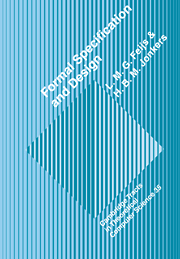Book contents
- Frontmatter
- Contents
- List of figures
- List of tables
- Preface
- I Algebraic specification
- II State-based specification
- 5 From algebras to states
- 6 Setting up state-based specifications
- 7 Structuring state-based specifications
- 8 Implementing state-based specifications
- III Advanced techniques
- Bibliography
- A Syntax
- B Standard library
- Index
5 - From algebras to states
Published online by Cambridge University Press: 02 November 2009
- Frontmatter
- Contents
- List of figures
- List of tables
- Preface
- I Algebraic specification
- II State-based specification
- 5 From algebras to states
- 6 Setting up state-based specifications
- 7 Structuring state-based specifications
- 8 Implementing state-based specifications
- III Advanced techniques
- Bibliography
- A Syntax
- B Standard library
- Index
Summary
Introduction
Part I introduced a collection of notations and techniques for algebraic specifications. These notations and techniques are relatively close to usual mathematics. As already shown by the examples of Part I, algebraic specifications suffice to describe a wide range of data types (Booleans, numbers, sets, bags, sequences, tuples, maps, stacks, queues, etc.) and they can even be used to describe syntax and semantics of languages, to describe rules and strategies of games and to describe many more non-trivial aspects of complex systems. Of course there are some differences between the notations and techniques of Part I and usual mathematics, like the restriction to first-order predicate logic with inductive definitions, the special way of treating partial functions and undefinedness and, most of all, the modularisation constructs. The latter difference reveals that COLD-K has its roots in software engineering and systems engineering, rather than in general purpose mathematics.
There is one more phenomenon which is characteristic for many branches of software engineering and systems engineering: special provisions for describing state-based systems.
- Type
- Chapter
- Information
- Formal Specification and Design , pp. 113 - 142Publisher: Cambridge University PressPrint publication year: 1992

